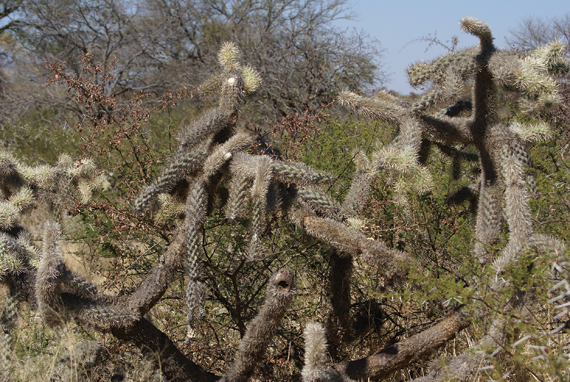
SCORES of Sengezane villagers in Gwanda district took to cultivating the poisonous cactus rosea plant also known as opundia fulgida in the late 1970s as it was regarded as a lightning insulator.

NQOBILE BHEBHE CHIEF REPORTER
According to villagers, the plant which the locals call magnet was thought to have supernatural powers to protect them from lightning.
At the time, it showed no signs of being deadly to both livestock and humans.
However, several decades down the line, the plant is wreaking havoc in most parts of Matabeleland South.
Official records indicate that more than 40 livestock, which include 21 goats, 16 cattle and four donkeys, were injured after coming into contact with the plant.
The threat posed by the cactus was bought to the limelight after extensive research by award-winning researcher and lecturer Buhle Francis of the National University of Science and Technology.
- Chamisa under fire over US$120K donation
- Mavhunga puts DeMbare into Chibuku quarterfinals
- Pension funds bet on Cabora Bassa oilfields
- Councils defy govt fire tender directive
Keep Reading
Francis has won international awards for researching on the invasive weed that has spread over 3 000 hectares in Matabeleland South.
Francis, from Gwanda, was recently credited by the National Assembly for her role in shedding light on the plant that has killed livestock in Matabeleland South.
Shurugwi South MP Annastacia Ndhlovu made a passionate plea to the government to provide funds estimated at $2,5 million to eradicate the poisonous plant.
Francis said after her research, she spelled out an action plan to be taken.
“I recommended that the government should act on the matter with speed. There should be a base management practice as eradication is not possible,” she said.
“I am happy that the research I did has attracted the attention of the government through Parliament” Francis said Zimbabwe should learn from other countries.
“South Africa had a similar problem and an insect which is host specific was released from Pretoria to Limpopo about three years ago. They have not had a problem since.
“The insect attacking biological control is called dactylopius tomentosus, but commonly known as coclineal or mealybug. It is host specific meaning that it attacks a particular species,” she said.
During a visit to the district last week, Southern Eye saw large swathes of grazing land covered by the plant.
Villagers warned the crew not to draw closer to the plant as it can “miraculously jump onto any moving object with a devastating effect”.
David Maphala, whose homestead is surrounded by the plant, said he was surprised by the sudden deadly potency of the plant.
“I first saw the plant in the 1970s while I was working as a meteorological officer at Thuli Breeding Station. A white man who was in charge of the station and would bring the plant from Cape Town (South Africa),” Maphala said.
“He used to grow the plant around his fowl runs. He said he wanted to ward off snakes. It was not deadly to humans. The thorns are too sharp hence snakes stood no chance of slithering through,” he said.
However, Maphala said some years later villagers developed a theory that the plant could come in handy in protecting homesteads from lightning.
“We call the plant magnet. It grows well in arid areas. If a branch falls off, within days it would just grow,” he said.
“It’s more deadly when small branches are on the ground as it just leaps to the air when animals or humans pass close to it.
“So villagers began to believe that it can protect them from lightning. That resulted in many growing the plant around their homesteads.”
Asked if it indeed protected them from lightning, Maphala burst into laughter and said: “Sasiloyiwe (we had been bewitched)” as several homesteads were periodically struck by lightning.
Maphala’s neighbour, Fessy Ncube, said the sudden menace was alarming.
“It saddens me to see my cattle writhe in pain after being pricked. The grazing land is fast being covered by the plant and we are helpless,” Ncube said.
“With the assistance of EMA (Enviromental Management Agency) we have tried to clear many potions of land, but the problem is that within a few days it grows again. We have also tried to burn the branches, but that is not helping.
“We appeal to the government or researchers to come up with a lasting solution of disposing of the plant.”
Franscis said the poisonous opuntia fulgida, known in the scientific community as cylindopunta fulgida varfulgi, grows up to two metres in a cluster form and thrives in dry conditions and prefers very poor soils and rocky areas.
The prickly part of the plant is seven centimetres long and has several numbers of irregular jointed branches bearing sharp-barbed spines that are painful and difficult to remove.
“So those worse affected areas in Matabeleland South have all the conditions. It’s the right place to grow,” she said.
Since its joints separate easily, they appear sometimes to “jump” to attack passers-by, hence Guyu villagers terming it magnet.
FACT FILE: Cactus rosea THIS invasive species is mainly found in Matabeleland South Province with severely affected districts being Gwanda and Beitbridge.
It thrives in the very dry and rocky region spreading from its source areas of the confluence of Umzingwane and Limpopo rivers.
The plant is spreading to other districts and isolated cases have been identified in Insiza and Bulilima.
Socioeconomic and ecological effects of the plant
- The plant is covered with strong thorns that easily injure both humans and animals,
- It displays magnetic characteristics. Once it prickles into the skin, the pain is unbearable and the thorn is not easily removable. Persons have to undergo surgical operations to remove the thorns,
- The plant is commonly found in pasture land exposing livestock to its attacks,
- The weed propagates vegetatively and rapidly fast thereby reducing both pasture and arable land,
- It has already displaced some people from their homestead,
- Wild animals are trapped by the plant leading to their deaths.
- How it spreads
- The weed detaches from the plant with the slightest touches and attaches to humans/animals,
- Livestock easily spreads the weed to watering points, dip tanks and grazing land as they roam around,
- People have been fooled by the attractiveness of the plant’s purplish flowers and have planted it in their homes as an ornamental plant.
– EMA










